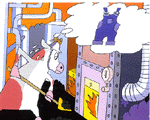
| Anna Geréb | The tenth birthday of Varga Studio |

|
 65 KByte |
After Korda, Halas, and their people, respectively, Varga's team is the third Hungarian undertaking that brings fame to the British film industry! In 1989, as the first private, independent animation studio, they started business with a five member team, HUF 1 million basic capital, HUF 2 million business, 10 minutes of programme. This by now has expanded to 250 people, HUF 35 million basic capital, HUF 650 million business, 15 hours of finalised film material! (This, by the way, is a European record.) This success is greater then what the founding fathers, Csaba Varga and András Erkel or producer Jenő Vass had ever dreamed of. And we haven't mentioned the international success, awards from Annecy through Berlin to Kecskemét, and the fact that a world leader company like Warner Bros. uses them for advertising itself! From Middle- and Eastern-Europe they have been the only ones to set their feet onto the British animation market. From sub-contracted "slave-labourer" working for big companies, Varga Studio quickly turned first into a partner of its co-production contractors, then into an independent workshop with its own productions, the rights of which remain its property even if others contribute to the financing. On 29th March, on the studio's anniversary party on Hajósziget, at the press conference held between the show and the dinner we heard pieces of interesting information on the possibly most successful Hungarian film production company. They themselves explain their success with the following: 1. They work with Western technology, management and work ethics (naturally for Western salaries). 2. Around the political changes many talents came from the neighbouring countries, Slovenia, Bulgaria, Serbia and mainly Russia, which brought significant changes into the Hungarian animation, the mixing of several cultures effectively revitalised the style. 3. The worldwide tendency of the second renaissance of animation has worked in their favour. This, by the way is to be thanked to another Hungarian talent, Gábor Csupó, it was his success in the US that broke the ice. His series lifted animation from the pit up to the "serious" movie screen or prime time television screen. This filtered over to us and by that time Varga and his people were both technically and artistically prepared to meet the demand. 4. Computer games prepare the young generations for animation and make them accustomed to stylised figures or puppets. 5. Computer technology enhances the use of animation, it breaks into live action films, there are no longer spectacular feature films without animation (e.g. Titanic or the latest episode of Star Wars, where it is almost impossible to draw the line between real actors and the animated virtual world they move in.) As a result of this Varga Studio can now afford besides the ordered series and commercials to create original, sophisticated art films and give way to the individual creative mind. This is not only true to production, as in the case of Don Quixote made in cooperation with S4C, BBC and HBO, where the "order" was restricted to topic, in every other activity they were given independence, but they can also realise own ideas, what's more, "produce" inventors. They have their own foundation for beginners and a school for the next generations of beginners. Their search for talents has produced an outstanding result in the person of Aleksei Alekseiev, Russian atom-physicist made world known director, who was hired by the Americans to make the whole Baby Blues series. They have other novelties as well, e.g. the Centrum-programme. This is already the technology of the 21st century. A way of "remote control" work, the designers and drawers make, design, paint the phases, backgrounds in their own "centres", or rather computers, and send them through the internet to the studio where work is being done on 40 terminals (while they turn to traditional "handcraft" if the artistic idea requires that). It is to be considered "an extra bonus" that they take special care for using more and more challenged, mainly physically disabled young people - at present 20 of them work in the studio. National animation cannot exist without national television, and television cannot live without animation. This is one of the biggest lucks of Varga Studio. And their misfortune as well. Hungarian Television doesn't invest money into Hungarian animation. RTL Klub is the only connection to the Hungarian market. We, viewers again are being left out of something... But let's stop complaining now. After all, we are celebrating a birthday here. The tenth anniversary of a success story. Let's wish them unceasing drive for the next decades! |
 73 KByte |
